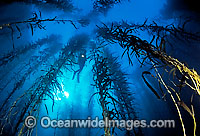
Giant kelp Macrocystis pyrifera and
scuba diver. |
|
Deep in the forests celebrated for
its alpine scenery, Tasmania offers equally wondrous sights
beneath its seas. One of a handful of places in the world
where giant kelp can flourish, a dive in these submarine
forests opens a window on a hidden domain of astonishing
diversity. Some 30 metres below, at the foot of the forest.
The caves and drop-offs are decorated with a carpet of southern
jewel anemones ‘Corynactis australis’
(left).
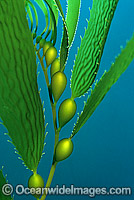
Giant kelp Macrocystis pyfifera holdfasts
(left). Gas filled giant kelp Macrocystis
pyfifera floats ( right). |
|
FORMIDALBE GROWTH
On their way to the surface, 'Macrocystis pyrifera'
kelp stems are supported by hundreds of gas-filled floats
(top right), each forming a base from which the ribbon-like
fronds sprout. A plant standing in 20 metres of water (left)
may include a similar length resting on the surface. This
allows it to maximise photosynthesis and generate a prodigious
growth rate. In fact, it is the fastest growing plant in
the world. Under optimum conditions of sunlight, nutrients
and temperature, growth can reach half a metre a day, providing
a renewable food source and home for up to half a million
invertebrates per plant. Some, like the pink gastropod 'Cantharidus
eximius' (below right) graze continually and though
in some patches we found them in numbers, closer inspection
revealed no visible harm to the plants.
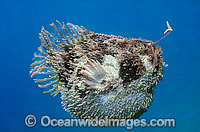
Tassled anglerfish Rhycherus filamentosus
showing "rod and lure" |
|
HIDE AND SEEK
With a well developed “rod and lure”
(top left) dangling in front of a cavernous mouth, the disruptive
garb of the tasselled anglerfish 'Rhycherus filamentosus'
(bottom left) seals the fate of many an unsuspecting fish.
Indeed, had it not moved as we finned past it would have
been dismissed as a clump of seaweed. Being one of the strongest
swimmers in its family, luck was on our side when it quickly
settled down for a photo session, and as long as we stayed
outside its “critical distance zone”, it seemed
quite convinced we couldn’t see it. Perhaps not so
confident of its camouflage, Johnston’s weedfish ‘Heteroclinus
johnstoni’ is another cryptic species. Giving
birth to live young, this variety is one of the largest
in the family.
| 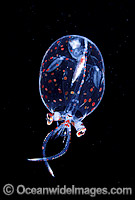 Internal protection: Practically invisible,
this marble-sized cranchid squid Teuthowenia
sp. would have remained unnoticed had it
not bumped into my face mask. A rare find, it
was probably washed in on an upwelling from
deeper water. In response to our camera flash
units, the tiny creature pulled its head, tentacles
and stalked eyes completely inside its body
and appeared to mimic a sea jelly - a cunning
bluff for would-be predators. Very little is
known about the life history of this elusive
species.
Internal protection: Practically invisible,
this marble-sized cranchid squid Teuthowenia
sp. would have remained unnoticed had it
not bumped into my face mask. A rare find, it
was probably washed in on an upwelling from
deeper water. In response to our camera flash
units, the tiny creature pulled its head, tentacles
and stalked eyes completely inside its body
and appeared to mimic a sea jelly - a cunning
bluff for would-be predators. Very little is
known about the life history of this elusive
species.
|
|
LYING AT THE
CONFLUENCE OF several biogeographical regions,
Tasmania offers a diversity of marine life that is unsurpassed
in the world's temperate seas. Off the island's southern
shores, cold water drawn to the surface by passing currents
supports species usually confined to greater depths.
IN REMOTE AREAS OF the south-east, an extraordinary
collection of endemic species occur, while in the north,
the more familiar species from New Zealand, New South Wales
and the southern coast of the Australian continent are to
be found.
BUT BY FAR THE most striking feature of Tasmania's
waters are the luxuriant stands of giant kelp 'Macrocystis
pyrifera' (above left) that fringe the coastal shallows,
especially the Tasman Peninsula, like corridors of submarine
forest. Held buoyant by gas-filled bladders, ranks of these
outsized seaweeds sprout a dense carpet of fronds that rest
on the surface, washing back and forth on the swell.
BELOW, BENEATH THE
sun-drenched canopy, lies a world of shadows and dappled
light, the stage for a million mini-dramas of life and death.
Only on a passport supplied by bottled air can one appreciate
the complexity of this hidden microcosm. All my years as
an underwater photographer had not prepared me for the ghostly
beauty and proliferation of life to be found in these submarine
jungles. Sea urchins, anemones, gastropods, shrimp, fish
and an "encyclopaedia" of smaller organisms on,
and amongst, the kelp. Masters of disguise, weedy sea dragons
and crested weedfish, now you see them, now you don't, float
through the liquid tapestry.
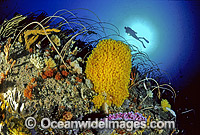
Tasmania's colourful temperate reefs. |
|
DOWN ON THE rocky bottom, between the kelps' claw-like
holdfasts, shafts of sunlight reveal crevices bristling with
crayfish and hand-sized abalone. The simple ingredients of
sunlight, water, minerals and carbon dioxide converted to
living buildings, the kelp forest is a submarine city bustling
with life from street level right up to the penthouse suite.
FURTHER DOWN, beyond the reach of the light which
supports the giant forests, are the deep reefs and submarine
gardens. Usually found in strong currents, gardens of filter-feeding
sponges, sea whips, jewel anemones and zoanthids thrive
in the still, nutrient-rich water - a torch beam transforming
the dull browns and blues to dazzling yellows and oranges.
WITH THE HELP OF my wife and assistant Meri, and
several well-placed underwater lights, I felt satisfied to
have immortalised at least a few images of this twilight world
for others to share.
|

Giant king crab Pseudocarcincus gigas.
|
|
GROWTH INDUSTRY
Despite its formidable looking claws, this king
crab ‘Pseudocarcinus gigas’ (left)
showed little aggression when we approached it. At 15 kilograms
it is one of the world’s largest crabs and has recently
become the subject of a newly developing fishery. Generally
a deepwater species, in the past most specimens were taken
as by-catch in lobster pots or brought up in trawls, but
now they are being targeted with robust, specifically designed
traps. Even though knowledge of its biology is scant, management
strategies, including restrictions on size and reproductive
condition, have already been implemented to stop short-term
exploitation.
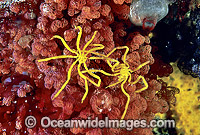
Yellow sea spiders Pseudopallene ambigua. |
|
ANOTHER CREEPY
CRAWLY from Tasmanian waters, and one with significantly
less commercial potential, is the yellow sea spider ‘Pseudopallene
ambigua’. Often living on their food source,
such as this bryozoan, sea spiders incubate their eggs attached
to special carrying legs, a duty performed by the male.
Sea spiders are no more closely related to terrestrial spiders
than the swimming sea anemone 'Phlyctenactis tuberculosa’.
Moving from place to place by releasing its adhesive pad
and rolling with the current, it is commonly found attached
to kelp and seagrasses, an unusual preference for an anemone.
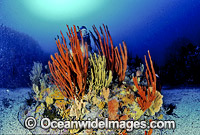
Tasmania's temperate reefs - colourful whip
and sponge gardens.
|
|
LIGHTS...AND ACTION
At 35 metres down absence of light releases sponges and
other filter feeders from competition with algae. Off Bicheno,
on Tasmania’s east coast, we were rewarded with some
of Australia’s most spectacular and diverse invertebrate
gardens. Our powerful underwater lights transformed a dull,
grey bottom into a magical world where huge finger sponges
thrust skyward like clusters of colourful smokestacks. The
sea whips, zoanthids and sponges pictured here represent
a small sample of the profusion of shapes, patterns and
colours on display.
Deadly Southern Blue-ringed octopus Hapalochlaena
maculosa swims 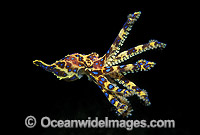 using
jet propulsion through siphon nozzle. Blue rings
flash to warn would-be predators to stay away. using
jet propulsion through siphon nozzle. Blue rings
flash to warn would-be predators to stay away. |
|
MINI KILLER
This flashing display put on by a southern blue-ringed octopus
'Hapalachlaena maculosa' is not for aesthetic purposes.
A bite from this diminutive (12cm) creature can kill an
adult in less than 15 minutes. This specimen was uncovered
when we overturned a small rock to see what was sheltering
beneath. Obligingly, it gave a display of its graceful swimming
action, allowing us to snap several shots which clearly
show its means of jet propulsion through the siphon nozzle.
But when it attached itself to my regulator hose I began
to wonder how badly I really needed a set of action shots!
Text: Gary Bell
Photography: Gary Bell
|

